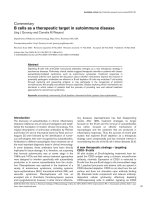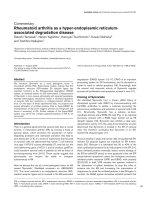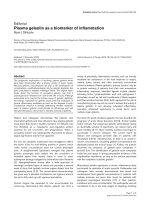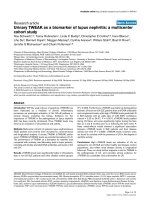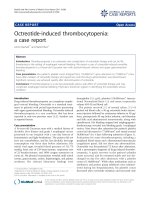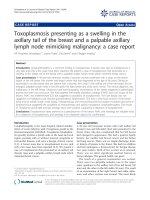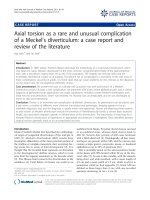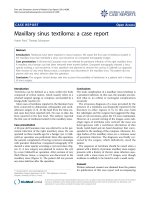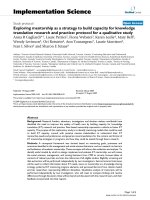Báo cáo y học: " Axial torsion as a rare and unusual complication of a Meckel’s diverticulum: a case report and review of the literature" ppsx
Bạn đang xem bản rút gọn của tài liệu. Xem và tải ngay bản đầy đủ của tài liệu tại đây (605.29 KB, 4 trang )
CAS E REP O R T Open Access
Axial torsion as a rare and unusual complication
of a Meckel’s diverticulum: a case report and
review of the literature
Ajai Seth
1*
and Jai Seth
2
Abstract
Introduction: In 1809, Johann Friedrich Meckel described the embryology of a small bowel diverticulum, which
now bears his name. Meckel’s diverticulum is the most common congenital abnormality of the gastrointesti nal
tract, with a prevalence ranging from 1% to 4% of the population. The majority are clinically silent and are
incidentally identified at surgery or at autopsy. The lifetime risk of complications is estimated at 4%, with most of
these complications occurring in adults. It is these cases that can cause problems for the clinician, as the diagnosis
can be elusive and the consequences extremely serious.
Case presentation: We present the case of a 68-year-old Caucasian man with axial torsion of a Meckel’s
diverticulum around its base, a rare complication. He presented with acute, severe abdominal pain, and a clinical
diagnosis of perforated acute appendicitis was made. Laparotomy revealed a torted Meckel’s diverticulum with
distal necrosis and perforation, which was resected. His recovery was uncomplicated, and he was discharged to
home six days post-operatively.
Conclusion: Torsion is an extremely rare complication of Meckel’s diverticulum. Its presentation can be elusive, and
it can mimic a number of different, more common intra-abdominal pathologies. Imaging appears to be an
unreliable diagnostic tool, and the diagnosis is usually made intra-operatively. Factors pre-disposing these patients
to axial torsion of Meckel’s diverticulum include the presence of mesodiverticular bands, a narrow base, excessive
length, and associated neoplastic growth or inflammation of the diverticulum. The importance of searching for a
diseased Meckel’s diverticulum at laparotomy in appropriate circumstances is highlighted. Once identified, prompt
surgical excision generally leads to an uncomplicated recovery.
Introduction
Johann Friedrich Meckel first described the embryologi-
cal origin of congenital diverticulum of the mid-gut in
1809 [1]. Meckel’ s diverticulum (MD) results from
inco mplete obliteration of the most proximal portion of
the vitelline or omphalo-mesenteric duct occurring dur-
ing weeks five to seven of fetal development [2]. It is
thought that the terminal band represents an aberration
in the developmental vitelline arteries, which in turn
arise from the superior mesenteric or the ileocolic artery
[3]. This fibrous band connects the diverticulum to the
umbilicus [4]. Total failure of closure can result in an
umbilical fecal fistula. Proximal ductal closure can lead
to an umbilical sinus, whereas distal closure leads to
MD [5]. Seventy-four percent of MD cases terminate
with a blind distal end [5]. Histologically, all four intest-
inal layers are present within MD, and the mucosa may
contain ectopic gastric, pancreatic, jejuna, or duodenal
epithelium in up to 50% of specimens [5,6].
MD is invariably found on the anti-mesenteric border
of the ileum, with 90% located within 90 cm of the ileo-
cecal valve [2]. Its size is also variab le, with the majority
being short and wide-mouthed, with a mean length o f
2.9 c m and a mean width of 1.9 cm, which is why it is
sometimes called an ileal appendix [7]. Giant MD are
defined as those larger than 5 cm, with one recorded
specimen measuring 16 cm × 4 cm [2].
* Correspondence:
1
Brighton and Sussex Medical School, University of Sussex, Falmer, Brighton
BN1 9PX, UK
Full list of author information is available at the end of the article
Seth and Seth Journal of Medical Case Reports 2011, 5:118
/>JOURNAL OF MEDICAL
CASE REPORTS
© 2011 Seth and Seth; licensee BioMed Central Ltd. This is an Open Access article distributed under the terms of the Creative
Commons Attribution Li cense ( which permits unrest ricted use, distribution, and
reproduction in any medium, provided the original work is properly cited.
MD is more often d iagnosed in men, as they are more
prone to complications [1]. The most common childhood
complication is rectal bleeding due to ileal peptic ulcera-
tion secondary to ectopic gastric mucosa [7,8]. Intestinal
obstruction is the more common presentation in adults,
caused by either intussusceptio n or small bowel volvulus
around a diverticular band anchored to the anterior
abdominal wall. Other c ommon complications include
acute inflammation leading to perforation and hemor-
rhage [1]. Rarer complications include MD perforation
with foreign bodies, strangulation in Littré’s hernia, pri-
mary neoplasms, or v esicodiverticu lar fistulae [7,9]. Axial
torsion of MD is an extremely rare complication [1,10].
Torsion of MD is the result of axial twistin g around its
base. This can occur around a persistent mesodiverticular
band or with an absent band and a free-ended diverticu-
lum. The exact mechanism for this is unclear. The degree
of torsion varies and can compromise diverticular circu-
lation, leading to necrosis and perforation [2].
Case presentation
A 68-year-old Caucasian man presented to our hospital
with acute, severe abdominal pain. An examination of
the patient revealed that he was septic and had a dis-
tended abdomen w ith rebound tenderness in the hypo-
gastrium and the right iliac fossa. His rectal examination
was unremarkable. His blood test revealed a raised
white cell count, 15.4 × 10
3
/μl, and a high C-reactive
protein level at 208 mg/L. The patient had normal renal
function and a normal hemoglobin level. An abdominal
radiograph revealed dilated small bowel loops, and a
clinical diagnosis of perforated acute appendici tis was
made. No other pre-operative investigations were carried
out, and following fluid resuscitation, a laparoscopy was
performed.
Laparoscopy r evealed purulent fluid within the pelvis.
The appendix could not be visualized, but the p eri-
appendicular region appeared normal. The laparoscopy
was converted to a laparotomy. Surgical exploration
revealed a torted MD with distal necrosis and perfora-
tion. The necrose d tip of the diverticulum was adherent
to the adjacent mesentery (Figure 1). The appendix, the
rest of the bowel, and the viscera appeared normal. The
twisted MD was resected along with an 8 cm flange of
ileum that was encompassed within the vascular terri-
tory of the inflamed, unhealthy, and friable mesentery.
An end-to-end seromuscular, single-layered anastomosis
using a 4-0 synthetic absorbable suture, was performed
to restore the continuity of the small bowel. Thorough
washout of the peritoneal cavit y was performed, and a
pelvic drain was inserted. The patient’s recovery was
uncomplicated, and he was discharged to home six days
post-operatively with routine follow-up.
Discussion
Thi s case report presents the unus ual case of torsi on of
MD. By reviewing the previous literature, we aim to
identify the possible etiology, main clinical features,
appropriate investigations, and operative management
associated with this variant.
The etiology of axial torsion of MD remains unclear.
On the basis of the available literature, we have identified
several risk factors. Although primary neoplasms arising
within MD is rare, representing less than 1% of cases
[11], they may be a potential risk factor. A large review of
1605 cases of complications of MD identified only 24
cases [9]. A variety of benign and malignant histological
types have been reported, including leiomyoma, fibroma,
hemangioma, neurofibroma, carcinoid tumor, adenocar-
cinoma, fibrosarcoma, and leiomyosarcoma [11]. Benign
lesions within MD, such as lipomas, have also been
recognized as a potential cause of torsion [12]. Complica-
tions associated with this presentation include intussus-
ception, with the tumor as the lead point, mechanical
intestinal obstruction, volvulus, inflammation, and axial
torsion [13]. Fibrous vitelline bands may exist and con-
nect the MD to the abdominal wall, increasing the
chance of its torting [5]. An increase in diverticular
length and the size of the base is an important predispo-
sition for all types of complications [14]. The larger and
longer the MD, the greater the risk of torsion [2]. This
risk is increased further if the MD has a narrow neck and
is less likely to tort around a wider neck [14,15].
Pain is always a presenting feature of a torted MD but
is more frequently localized to t he right lower quadrant
[16]. Pain duration may range from 24 hours of colicky
episodic pain to three years of intermittent pain.
Figure 1 The intra-operative finding of a torted Meckel’ s
diverticulum with distal necrosis and perforation. A torted
Meckel’s diverticulum with distal necrosis and perforation was found
during surgery. The necrosed tip of the diverticulum was adherent
to the adjacent mesentery with a normal appearance of the rest of
the bowel and viscera. The twisted Meckel’s diverticulum was
resected along with an 8 cm flange of ileum.
Seth and Seth Journal of Medical Case Reports 2011, 5:118
/>Page 2 of 4
The patient described by Tan and Zheng [1 4] was dis-
covered to have a giant MD, which was thought to be
causing repeated episodes of torsion and ischemia dur-
ing this time. The pre-operative diag nosis of MD is
rarely considered [4] . Common incorrect diagnoses have
included appendicitis [17], small bowel obstruction, cho-
lecystitis, or an amoebic liver abscess. The latter c ase,
reported by Webster [18], represents a case of an MD
that was fixed within a sub-phrenic location. The mobi-
lity o f MD can therefore determine its clinical features,
which vary with its position within the abdomen. There-
fore, it can also make radiologic al investigation confus-
ing. When clinically suspected appendicitis is
insuff icientl y inflamed, further abdominal explorati on is
important [16].
Because of its various forms of presentation and unreli-
able imaging, torsion of MD is frequently misdiagnosed.
Special investigations appear to have little value in the
diagnosis of acute MD complications. Abdominal radio-
graphs are usually normal but may reveal an ileus or
perforation [4]. Less common radiographic appearances
have included gas-filled diverticula being mistaken for
emphysematous cholecystitis, intussusception in infants,
and even a report of MD containing calculi simulating
gallstones [8]. Ultrasound may exclude intussusception,
which can avoid u nnecessary interventions such as
attempts at reduction by the use of enemas. The MD
appears similar to the bowel, with a layered wall; however,
when torted, it mimi cs a cystic, tube-li ke, non-peristaltic
structure [8]. The major difference is acute appendicitis. A
larger size and a location far from the ileocecal region
would favor the diagnosis of axial MD torsion [8]. Com-
puted tomographic scans may also be misleading, as
described in case reports of a torted MD’s being mistaken
for a loculated cystic pelvic mass [3,19].
Appendicitis is the main pre-operative diagnosis, while
other diagnoses include small bowel obstruction, acute
cholecystitis, and liver abscess [2,18,20]. Macroscopic
intra-operative observations have been reported as tor-
sion, ischemic appearance, hemorrhagic, gangrenous,
and perforated with purulent peritonitis [10]. A further
observation fro m the previous literature is that the
degree of torsion is inversely proportional to the viabi-
lity of the MD. In cases where there is a greater degree
of torsion, there is also a greater vascular compromise
to the MD [2]. This risks infarction and perforation,
which a re associated with greater morbidity. The post-
operative period may be complicated by intra-abdominal
abscess or either clinical or microscopic evidence of
lower gastrointestinal bleeding [10,20].
The management of symptomatic MD is surgical
resection. A wedge resection of the MD is generally car-
ried out, and occasionally some ileum is resected by
end-to-end anastomosis [7]. Diverticulectomy for MD
found incident ally has been criticized, as a potential 800
asymptomatic resections are required to prevent a single
patient from complicatio ns [5]. However, if the MD is
left intact, any fibrous bands attached to it must be
excised to prevent any future torsion or obstruction [5].
Conclusion
In summary, this case report describes a patient with
torsion of MD. Imaging appears to be unreliable in the
detection of torted MD, and the diag nosis is usually
made intra-operatively. Major risk factors for torsion
appear to include an increased size of the MD with a
narrow base, potentially compromising blood supply
and leading to gangrene, the presence of a fibrous
mesodivertic ular band, an d the rare prese nce of neo-
plasm. The importance of suspecting MD pathology in
the differential diagnosis and its confirmation at lapar-
otomy has been highlighted. Once identified, prompt
surgical excision generally leads to an uncomplicated
recovery.
Consent
Written informed consent was obtained from the patient
for publicatio n of this case report and any accompany-
ing images. A copy of the written consent is available
for review by the Editor-in-Chief of this journal.
Acknowledgements
The authors thank Professor Harold Ellis for his contributions to preparing
and editing the manuscript.
Author details
1
Brighton and Sussex Medical School, University of Sussex, Falmer, Brighton
BN1 9PX, UK.
2
Department of Anatomy, School of Biomedical and Health
Sciences, Guys Campus, King’s College London, London, UK.
Authors’ contributions
JS was the surgical senior house officer who diagnosed the case. AS
performed the literature search. Both authors were involved in the writing of
the report.
Competing interests
The authors declare that they have no competing interests.
Received: 25 November 2010 Accepted: 28 March 2011
Published: 28 March 2011
References
1. Guss DA, Hoyt DB: Axial volvulus of Meckel’s diverticulum: a rare cause
of acute abdominal pain. Ann Emerg Med 1987, 16:811-812.
2. Limas C, Seretis K, Soultanidis C, Anagnostoulis S: Axial torsion and
gangrene of a giant Meckel’s diverticulum. J Gastrointestin Liver Dis 2006,
15:67-68.
3. Malhotra S, Roth DA, Gouge TH, Hofstetter SR, Sidhu G, Newman E:
Gangrene of Meckel’s diverticulum secondary to axial torsion: a rare
complication. Am J Gastroenterol 1998, 93:1373-1375.
4. Bronen RA, Glick S, Teplick S: Meckel’s diverticulum: axial volvulus
mimicking emphysematous cholecystitis. Am J Gastroenterol 1984,
79:183-185.
5. Moore GP, Burkle FM Jr: Isolated axial volvulus of a Meckel’s diverticulum.
Am J Emerg Med 1988, 6:137-142.
Seth and Seth Journal of Medical Case Reports 2011, 5:118
/>Page 3 of 4
6. Malik AA, Wani KA, Khaja AR: Meckel’s diverticulum: revisited. Saudi J
Gastroenterol 2010, 16:3-7.
7. Prasad TR, Chui CH, Jacobsen AS: Laparoscopic resection of an axially
torted Meckel’s diverticulum in a 13-year-old. J Laparoendosc Adv Surg
Tech A 2006, 16:425-427.
8. Gallego-Herrero C, del Pozo-Garcia G, Marín-Rodriguez C, Ibarrola de
Andrés C: Torsion of a Meckel’s diverticulum: sonographic findings.
Pediatr Radiol 1998, 28:599-601.
9. Moses WR: Meckel’s diverticulum: report of two unusual cases. N Engl J
Med 1947, 237:118-122.
10. Eser M, Oncel M, Kurt N: Gangrene secondary to axial torsion in a patient
with Meckel’s diverticulum. Int Surg 2002, 87:104-106.
11. Almagro UA, Erickson L Jr: Fibroma in Meckel’s diverticulum: a case
associated with axial and ileal volvulus. Am J Gastroenterol 1982,
77:477-480.
12. Karadeniz Cakmak G, Emre AU, Tascilar O, Bektaş S, Ucan BH, Irkorucu O,
Karakaya K, Ustundag Y, Comert M: Lipoma within inverted Meckel’s
diverticulum as a cause of recurrent partial intestinal obstruction and
hemorrhage: a case report and review of literature. World J Gastroenterol
2007, 13:1141-1143.
13. Niv Y, Abu-Avid S, Kopelman C, Oren M: Torsion of leiomyosarcoma of
Meckel’s diverticulum. Am J Gastroenterol 1986, 81:288-291.
14. Tan YM, Zheng ZX: Recurrent torsion of a giant Meckel’s diverticulum.
Dig Dis Sci 2005, 50:1285-1287.
15. Toshihiko W, Hirofumi O: Two cases of Meckel’s diverticulum torsion. Jpn
J Gastroenterol Surg 2002, 35:180-183.
16. Mackey WC, Dineen P: A fifty year experience with Meckel’s diverticulum.
Surg Gynecol Obstet 1983, 156
:56-64.
17. Kiyak G, Ergul E, Sarikaya SM, Kusdemir A: Axial torsion and gangrene of a
giant Meckel’s diverticulum mimicking acute appendicitis. J Pak Med
Assoc 2009, 59:408-409.
18. Webster JH: Torsion of subphrenic Meckel’s diverticulum. Arch Surg 1966,
92:318-320.
19. Farris S, Fernbach S: Axial torsion of Meckel’s diverticulum presenting as
a pelvic mass. Pediatr Radiol 2001, 31:886-888.
20. Sagar J, Kumar V, Shah DK: Meckel’s diverticulum: a systematic review. JR
Soc Med 2006, 99:501-505.
doi:10.1186/1752-1947-5-118
Cite this article as: Seth and Seth: Axial torsion as a rare and unusual
complication of a Meckel’s diverticulum: a case report and review of
the literature. Journal of Medical Case Reports 2011 5:118.
Submit your next manuscript to BioMed Central
and take full advantage of:
• Convenient online submission
• Thorough peer review
• No space constraints or color figure charges
• Immediate publication on acceptance
• Inclusion in PubMed, CAS, Scopus and Google Scholar
• Research which is freely available for redistribution
Submit your manuscript at
www.biomedcentral.com/submit
Seth and Seth Journal of Medical Case Reports 2011, 5:118
/>Page 4 of 4

